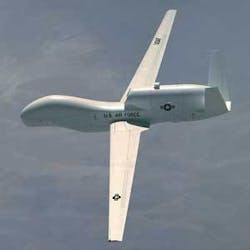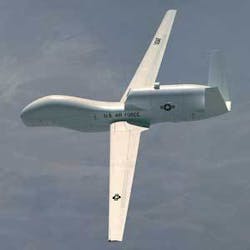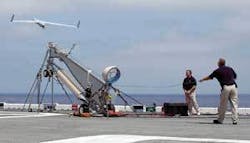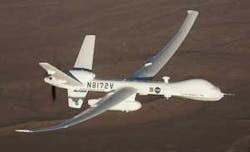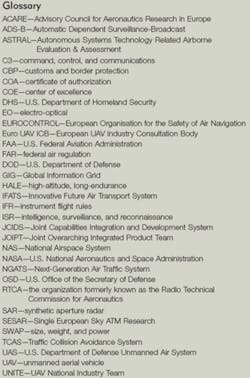Manned and unmanned aircraft to share controlled and commercial airspace
Governments, organizations, and industries throughout the world are trying to find ways of developing electronic and electro-optical technologies to enable unmanned aerial vehicles to operate together safely in controlled airspace with commercial jetliners, military aircraft, and private airplanes.
By J.R. Wilson
Avionics have always been central to most advances in the first century of manned flight-military and civil-enabling aircraft to operate over long distances, in inclement weather, day and night. In recent years, a wide variety of electronic and electro-optical systems have reduced the possibility of in-flight collisions, improved navigation and on-time operations, and laid the foundation for current plans to reduce separation.
The next major development in this evolution in electronics is likely to involve shifting some responsibilities from the ground to the aircraft. Some tasks now being performed by ground-based air-traffic controllers are expected to move into the cockpit, which will enable pilots to work with their flight-management computers to set their own courses on long-haul flights, independent of air-traffic controllers.
Avionics also have taken on an increasingly major role in the actual “piloting” of aircraft. It may have been a surprising comment to most moviegoers in 1970 when actor George Kennedy’s character in “Airport” growled, “That airplane can fly itself,” referring to an airborne 747 with no human pilot at the controls. It is true that advanced avionics do allow most modern jet aircraft, from 747s to F-117s, to take off, fly to their destinations, and land with little or no pilot “hands on.”
Often people do not recognize the value of a pilot until a spectacular accident happens. Prime examples are the Aloha Airlines 737-200 that lost a large section of the upper forward fuselage in an explosive decompression in 1988, and the United DC-10 that crashed in a ball of fire at Sioux City, Iowa, the following year after an uncontained failure of its tail engine destroyed all three hydraulic systems. The pilots of those aircraft saved the majority of their crew and passengers.
Although the steady advancement of computer speed, memory, and capability has brought equally advanced avionics into aircraft, airlines still rely on the skill and training of human pilots, not only in extreme emergencies, but also during normal flight operations.
This is a key reason that regulatory agencies, current and potential operators, industry, and the public are weighing in on the prospects of unmanned aerial vehicles (UAVs) flying in the national air space (NAS) alongside piloted-especially passenger-carrying-commercial, business, military, and general aviation.
“It is a question of when-not if-there will be certification of UAVs to fly on IFR [instrument flight rules] flight plans from point A to B,” says aviation consultant John Walker, president of JSWalker Group/Aviation Solutions in Lancaster, Pa. Walker, who served as program manager for airspace management at the FAA [U.S. Federal Aviation Administration] prior to his retirement in 2001, chairs the RTCA Special Committee 203/Minimum Performance Standards for Unmanned Aircraft Systems and Unmanned Aircraft.
“We realized we had to include UAVs, commercial space vehicles, and what are now called very light jets. Looking at what the next 10 to 15 years will be, now is the time to look at what the construct should be to allow all these vehicles to operate in the NAS, to consider how to have a transportation system going from ground systems to space-based,” he says. “I strongly believe the breakthrough in avionics for these systems will be applicable for manned and unmanned aircraft over the next decade or so.
“But as we increase the number of air vehicles in the air space-possibly including personal air platforms by the middle of the century-if we don’t resolve these issues now or soon, the likelihood of air incidents grows exponentially, even without unmanned aircraft.”
What the FAA demands of UAVs is an equivalent level of safety with manned aircraft, in which technology and human pilots work together to avoid conflict with other aircraft. Even with an operator somewhere on the ground, an unmanned system must combine an ability for the operator to make a decision with the UAV’s ability to act autonomously in the event of a loss of signal with the operator or if there is not enough time for human action due to signal latency. In such cases, the UAV will need to maneuver to avoid conflict, ensure all other traffic in the vicinity are aware of what it is doing, then return to course and notify the operator of what it has done.
Pilots of other aircraft in the area also should be able to anticipate the UAV’s actions based on an equivalent level of behavior or airmanship that is comparable to what a human pilot would do. Currently, only bits and pieces of that level of an autonomous sense and avoid system exist, many of them with size, weight and power (SWAP) problems for most UAVs, along with cost constraints for all.
In addition, creating such UAV situational awareness will be far easier to accomplish with passenger jetliners and other high-altitude aircraft that must be in radio contact with air-traffic controllers all the time, rather than with “noncooperative” general-aviation traffic operating in noncontrolled airspace. For small aircraft operating in open airspace, air-traffic controllers often have no information except position-usually provided by onboard RF transponders or relayed from other air-traffic controllers.
Those are among the problems that members of the SC-203 are addressing. The group is chartered with providing recommendations to help ensure that the DOD’s Unmanned Air System (UAS) operations are safe and compatible with other elements of the NAS architecture. In June 2006, the committee completed work on its first milestone, “Guidance Material and Considerations for Unmanned Aircraft Systems”; still to come are UAS Minimum Aviation System Performance Standards, MASPS for Command, Control and Communications (C3) Systems and MASPS for Sense and Avoid Systems.
Walker says the latter more accurately encompasses detect, sense, and avoid, going far beyond the Traffic Collision Avoidance System, better known as TCAS.
“It really is separation assurance and collision avoidance, mixing UAVs and manned aircraft in a controlled environment, with control towers giving instructions; a TCAS resolution advisory is either climb or descend,” he says. “What we are looking at in the committee and at DOD [the U.S. Department of Defense] goes well above any system we now have. I believe the technology is here for a hybrid of TCAS and ADS-B [Automatic Dependent Surveillance-Broadcast], as well as other technological advances-an innovative process that could blend in new avionics.
“One key thing that has to go into this, which dovetails into the Next-Generation Air Traffic System (NGATS), is the fourth dimension-time,” Walker continues. “That is the major challenge for the algorithms to create protective ‘bubbles’ around all aircraft. The time factor must go into the planning in order to keep these bubbles apart, which means some pretty complicated software. But I believe there will be evolutionary elements allowed by the FAA.”
It took two decades, with congressional mandates and funding, for TCAS to become a fixture in the system, Walker points out, and that system is still maturing. He says he believes it will be the same with UAVs because “just the cost and time of software development and testing will be a Herculean job.” It will depend on the contributions of groups, government, and industry.
“The DOD UAV Joint Overarching Integrated Product Team (JOIPT) is establishing a roadmap that is pretty solid,” he says. “They have two tracks; Track Two is long-term development and uniquely tied into what we are doing in SC-203. I’ve not seen a government enterprise before coming together as this one is.”
Pentagon leaders created the JOIPT was created in July 2005, alongside a Joint UAV Center of Excellence (COE), which they activated at Creech Air Force Base, Nev.-already home to the U.S. Air Force’s three Predator UAV squadrons and UAV Battlelab.
With representatives from all four military services, the U.S. Office of the Secretary of Defense (OSD), and major commands, JOIPT officials will focus on how to improve UAV system interoperability, and promote standardization and commonality through shared research and development. Office officials also will make recommendations to the joint capabilities integration and development system (JCIDS) process on how to meet warfighter requirements and will coordinate with the JUAV COE on overlapping questions and solutions.
Defense and aerospace companies also have begun working together on the problem. One such cooperative is the UAV National Industry Team (UNITE)-six U.S. aerospace companies that build high-altitude long-endurance (HALE) unmanned aircraft.
For two years, UNITE worked with NASA, DOD, the FAA, and the Department of Homeland Security in Access 5, which looked at how to achieve FAA certification for HALE UAVs to operate in the NAS before the end of the decade. A restructuring of NASA’s aerospace component in 2005-06 largely ended the agency’s involvement with UAVs, however, and Access 5 was disbanded.
Jeff Bauer at NASA’s Dryden Flight Research Center was the government project manager for Access 5 until its conclusion in February 2006.
“For the time we had, we made exceptional progress. When we began Access 5, the FAA referred to UAVs as remotely operated aircraft and only a handful of individuals, associated with military special ops, really knew anything about them,” he says. “That was inadequate for the FAA to deal with the revolution occurring in aeronautics as a result of the proliferation of those systems and the technologies they embody. Now the FAA has two program offices working to deal with the integration of UAVs and also support the formation of the RTCA command and control and collision avoidance issues.”
As for NASA itself, there remains an interest in helping test and develop UAV systems at Dryden-including using them to better understand a variety of flight phenomena-and as a user of the technology, primarily for atmospheric science studies.
“The technologies embedded in UAV systems will migrate into piloted systems to allow the whole ATC system to operate more safely and efficiently. The FAA is working to transform how the ATM will operate in 25 years and you can see that UAVs, honestly, are a better fit into that than piloted aircraft,” Bauer adds. “The applications UAVs are best suited for are providing capabilities that cannot currently be provided by any other form of air system.
“If we are going to maintain the NAS and extract the maximum benefit from it, that system will have to transform and evolve. UAVs are the current leading edge of that new technology, but you also will see applications for commercial space and the very light jet. All those forces will influence how the air transportation system evolves and I just don’t believe there could be any credibility to a report that would cause UAVs not to be a player in the future air transportation system.”
UNITE executive director Michael Heinz says the loss of Access 5 places the U.S. at a disadvantage as Europe moves forward with several similar organizations-Autonomous Systems Technology Related Airborne Evaluation & Assessment (ASTRAE) in the U.K., Single European Sky ATM Research (SESAR) at EUROCONTROL (European Organisation for the Safety of Air Navigation) and efforts by the European Union, including its Framework Program, Innovative Future Air Transport System (IFATS), the Advisory Council for Aeronautics Research in Europe (ACARE), and the European UAV Industry Consultation Body (Euro UAV ICB).
“The lack of a U.S. integrating initiative, at the same time that Europe forges ahead with public/private initiatives, raises concerns about sustained U.S. leadership,” he said in testimony before the U.S. House Transportation and Infrastructure subcommittee on aviation. “U.S. industry is eager to ensure that it remains in a leadership position as the market for civil and commercial UAVs starts to emerge and as the military use of UAVs continues to grow.”
Heinz told lawmakers “there are urgent needs to operate UAVs routinely in the NAS” and proposed a three-stage approach: in the short term to ensure that DOD and the U.S. Department of Homeland Security (DHS) can conduct critical missions and that industry can expeditiously flight test new products, in the mid-term to gain safe and routine access to the NAS, and in the long-term to integrate UAVs into the NGATS.
Equally important, according to Bauer, is a unified global approach to bringing UAVs into civil airspace. “If we figure out how to fly UAVs in our airspace but that is incompatible with how the rest of the world does it, we haven’t accomplished much,” he says. “We have to ensure everyone is on the same page when these issues get addressed and solved.”
Without a broad-spectrum solution, the FAA has been acting on a case-by-case basis in permitting UAV operations outside restricted military airspace in the U.S., largely at the behest of DHS and other federal agencies. In 2006 the FAA issued 62 certificates of authorization (COAs) for limited and specific UAV operations, primarily Customs and Border Protection (CBP) flights along the Mexican border and to assist the Forestry Service and others in firefighting. However, while those COAs are in place, the airspace involved is restricted to normal air traffic.
Those efforts nonetheless represent a significant change in FAA procedures.
“We came up with a COA fairly rapidly for UAV operations during the recent California forest fire-about six hours,” notes Tony Ferrante, director of the Air Traffic Safety Oversight Service in the FAA Office of Aviation Safety. “It normally takes about 60 days because of all the procedural issues, depending on altitudes, airspace, location, etc. For the CBP, for example, it was a fairly lengthy temporary flight restriction; they had to have provisions to depart from and return to an airport in order to get to the restricted space.
“The difference is, in the fire case, we already had restricted airspace and a certified operator-somebody with the ability to operate a UAV in the NAS-as opposed to others where you have to demonstrate the ability to do that, the airspace of operations, the level of restriction to protect the rest of the civil fleet, etc.”
In an effort to develop the regulatory framework and plan to safely integrate UAVs into the NAS on a broader, permanent basis, the FAA established an Unmanned Aircraft Program Office. Its first accomplishment was the release, in December 2006, of the first draft of an FAA roadmap to achieve an eventual “file and fly” capability for UAVs.
“That is the first time we will start mapping out all the steps necessary to get to that state,” Ferrante says. “We know the issues are detect, sense and avoid and communications and control and we will start looking at what government and industry need to work toward in terms of solutions. That could be a combination of cameras and sensors-if you look at the range of the human eye, can we mirror that and its perception with a camera? We just don’t know the answers yet.”
While saying the first steps have progressed fairly quickly, Ferrante does not expect to see a technology solution acceptable to the FAA in less than five years. Walker, meanwhile, says he does not expect to see the FAA anytime soon accept the military concept of one operator controlling several UAVs. “That is far down the road and something the FAA doesn’t even want to talk about right now,” he says.
But the current FAA COA process-which also includes a chase plane and observers on the ground-does not meet the needs of military or anticipated DHS operations. Which is why a DOD/DHS/FAA partnership needs to mitigate those restrictions in the short term and develop a new approach for the longer term, Walker says.
“That will help us go down the road to an evolutionary place that will resolve these issues-and still ensure safety is paramount-before these aircraft enter into the NAS with civil aircraft,” he says. “And that is what will be required to get the FAA to start signing off on a certification roadmap to a type certificate.”
While UAVs have been a sporadic part of the military arsenal since World War II, the success of the Pioneer as an intelligence, surveillance, and reconnaissance (ISR) platform during the first Persian Gulf War of 1991 was the first step in making them a permanent component. Their utility-and DOD commitment-grew rapidly during the 1990s, with UAVs active in the Balkans and as part of containment operations in Iraq.
Operation Enduring Freedom in Afghanistan in 2001 and the second Persian Gulf War in 2003 saw UAVs playing a pivotal role across the spectrum of military operations. That has continued to evolve through the decade, from communications and ISR to targeting and attack, and in size from the hand-launched Marine Corps Dragon Eye to the relatively massive Air Force Global Hawk.
This growing utility in battle has significantly increased the Pentagon’s interest in being able to fly its larger UAVs between military bases in the United States and around the world-which would require authority to operate outside restricted military airspace. The technology to meet the stringent requirements of the FAA and its global counterparts, such as EUROCONTROL, in large part may evolve from military requirements for the safe operation of the growing fleet of UAVs in the aviation battlespace, alongside manned fighter, transport, and other aircraft. The avionics required to accomplish that also will further advance UAV combat capabilities.
“A UAV cannot see what is around it, which limits its operations in controlled airspace. That has to be removed, so the vehicle can sense its immediate environment and react to those inputs to avoid collisions,” says Air Force Col. Michael B. Leahy Jr., material group director in the Air Force Research Lab Air Vehicles Directorate at Wright-Patterson Air Force Base, Ohio. “We need the ability to auto-reroute, being able to share the information of what that change will do with its partners.
“That is the true power of having it unmanned. If you always have a tether, a comm link, then the enemy will cut that tether and it becomes stupid. You must be able to hit a button to tell the UAVs to fly a mission, but also to avoid these sites and hit these.”
AFRL is working to develop sensors and related systems that can detect, sense, and avoid-giving UAVs a real-time situational awareness “bubble” in flight-as well as communicate intentions with each other and with manned aircraft. And accomplish that with as little impact on SWAP as possible, which is especially important to smaller platforms.
“If the user wants to increase capability, there will have to be some trade-offs for SWAP and cost-how much sensor payload or mission payload do they want to surrender. Our objective is make sure the first line system with the EO (electro-optical) sensors can be integrated with as little impact as possible,” notes Vince Raska, AFRL’s Sense and Avoid Program Manager at Wright-Patterson. “I don’t expect it to reflect the final version sense and avoid, but we want to minimize the equipment onboard-sensors, processors-and what has to be evaluated. There’s no point in designing a system that can’t be built or certified, but our role is to develop the technology and show the capability.”
Just as avionics developed for manned aircraft are now being applied to solutions for UAVs, Raska says what AFRL and others are developing to enhance UAV capabilities also will find their way into the cockpits of jet fighters and airliners, improving operational safety and creating the next step up from TCAS.
A major complication for certifying UAV operations in the NAS is “noncooperating” platforms-small, low-flying aircraft not required to have TCAS, such as crop-dusters, advertising tow-planes, gliders, helicopters, parachutists, and balloons. It is in that realm that detect, sense, and avoid become crucial.
“OSD sees integrating military unmanned systems into the NAS so we can file and fly as the ultimate goal. To get there, you must meet FAR requirements, primarily ‘see and avoid.’ How that is done is different among different aircraft,” explains UAV Battlelab commander and COE deputy commander Col. Larry Felder. “Once we have that, we need to come up with a technological solution, which is our charter at the Battlelab. We’re looking for a system that will allow us, electronically-E/O, IR, MMW, whatever is best of breed-to fit into a UAV autonomous solution that is really ingenious, easy to maintain and meets the FAR.”
Many of those solutions already exist, but could cost many times the price of the entire UAV to implement. Miniaturization and nanotechnology are seen as solutions, but come with new problems of their own, such as heat dissipation.
“Miniaturization will have a huge impact as an enabling technology, specifically in the area of avionics and sensor systems,” Felder says. “A good example of this is the Mini-SAR (Synthetic Aperture Radar) project we’re working on with Sandia Labs in New Mexico. They’ve brought us a SAR package that weighs around 27 pounds, so it can be used on a small, tactical UAV now. That was unheard of when Predator first took to the skies.”
“Another lab came to us with a Link-16 so small that it would allow us to put Link-16 into some very small UAV platforms and then be able to network what was once squad-level intelligence into the GIG [Global Information Grid]. That’s a big leap.”
Along with miniaturization is a further evolution of data fusion, not only internally but also across platforms, enabling several UAVs and manned aircraft to share information and generate a common-and more extensive-situational awareness.
“NASA, in its interplanetary efforts, has a software algorithm to enable spacecraft to update situational awareness, laying a digital synthetic environment over the real one. We think that can be applied to UAVs,” Felder says, an example of how the solutions to UAV NAS operations will come from a variety of sources.
That also includes industry, which currently is focused on military applications in wartime, but is coming under increasing pressure to find commercial uses. DOD is encouraging that because it would expand production and thus reduce acquisition costs. It also would put more money and ingenuity into new technology solutions, in keeping with the Pentagon’s continued focus on COTS for technology advancement and cost reduction.
Having a wide range of commercial customers-especially with platforms FAA-certified to operate in civil airspace-also would mean considerably more return on investment for UAV manufacturers. To that end, Felder emphasizes his three top priorities for industry: continued miniaturization of sensors is critical, work toward more autonomous operations, and find solutions for the saturated spectrum.
“That comes with a big caveat, however, because some of those solutions are already out there-but for our purposes, they must be size- and cost-appropriate. Sensors, for example, are hugely expensive now,” he adds. “What we in the UAV community need are smaller, more reliable avionics, and that takes up-front engineering costs to develop.”
Despite the termination of Access 5 and what he terms little sign of urgency from either Congress or the White House, Walker believes progress is being made on all fronts, although there remain some “chicken and egg” issues: the FAA wants technology answers before writing new regulations; operators and manufacturers want to know the regulatory landscape before committing to major new investments in technology.
“There are folks who say we have to have a deliverable system by 2009 and others who take the view we have a year or two of exploratory work that pushes that out to 2011 or 2012,” he says. “I believe the answer will be more clear in 2007, especially now that we have a specific partnership with the DOD JOIPT, which will put resources into the kind of qualifying research, testing, modeling and simulation that will be required.
“I can definitely sense a difference in the pace compared to five years ago. When is the tipping point? We’re not close, but well on the path.”
null
